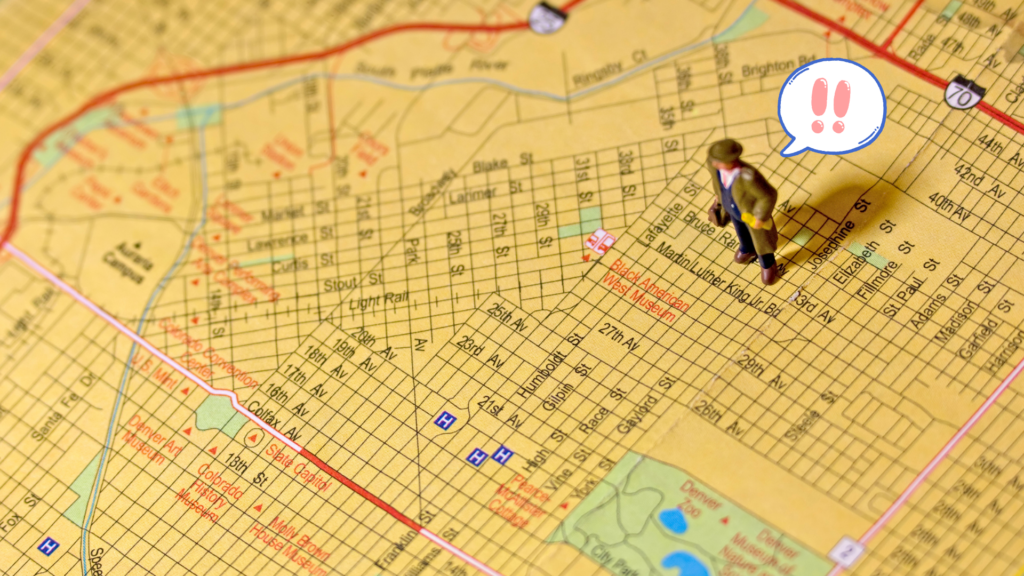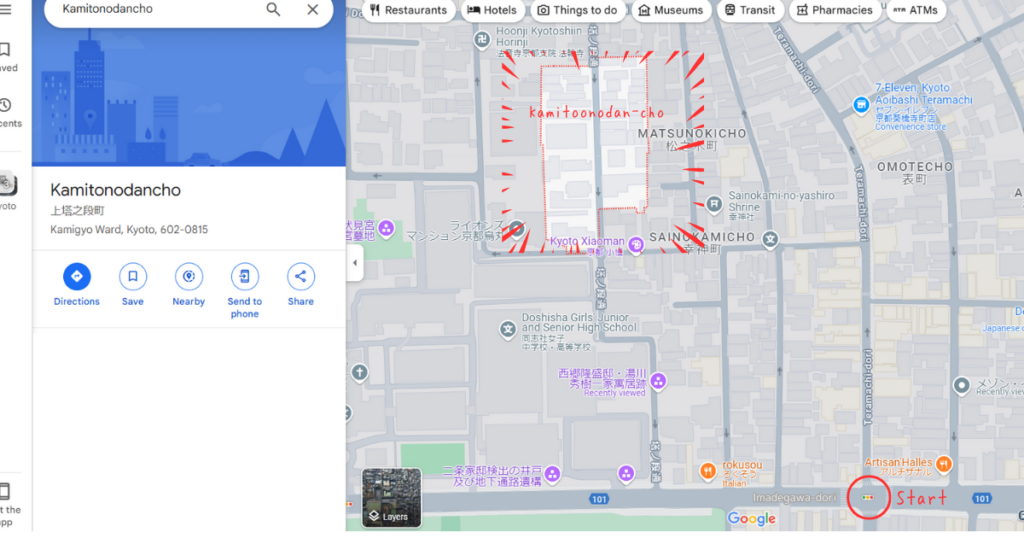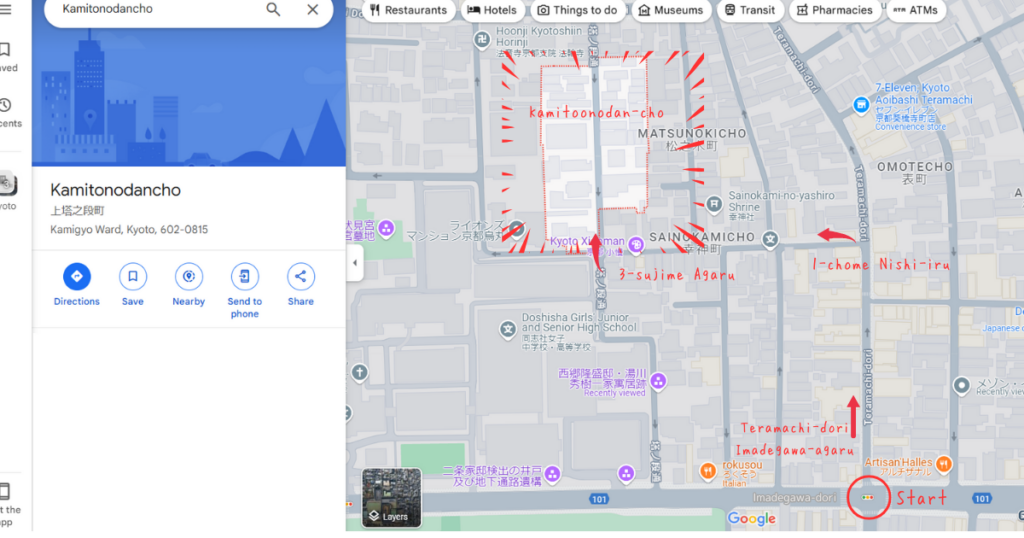In Japan, the new school and business year starts in April.
So spring is the season for moving and starting afresh.
Here in Kyoto, you’ll see moving vans everywhere at this time of year.
But, among all the new residents, we often hear people say:
“I’ve just moved here.
But I don’t understand how Kyoto’s addresses work!”
“Sanjo-dori Teramachi-agaru”?
“Karasuma-dori Oike-sagaru”?
Wait… where is that?
For someone seeing it for the first time, Kyoto’s addresses can seem like a secret code.
But, don’t worry – it’s not as hard as it looks!
Once You Know the Rules, Kyoto’s Address Are Actually Simple!

Kyoto’s address system is a little unique compared to other parts of Japan.
In most places in Japan, addresses are typically written like:
“Prefecture + City + Town + Block Number.”
But Kyoto’s addresses are little different.
You’ll often see addresses like:
“〇〇-dori (street name)” + “Agaru (上る)” or
“Sagaru (下る)” + town name.
The format is:
“Street name” + “Which direction to go from that street” + “Town name.”
Sometimes, the name of a temple is used instead of the street name.
This style is especially common in the central areas of Kyoto.
—like Kamigyo, Nakagyo, Higashiyama, and Shimogyo wards.
And yes, the addresses can be very long!!
It’s even mentioned on Wikipedia under the section for “Long Japanese Words.”
Here are some examples of Kyoto’s addresses
- 京都府京都市上京区寺町通今出川上る一丁目西入三筋目上る上塔之段町(32文字)
- Kyoto-fu Kyoto-shi Kamigyo-ku Teramachi-dori Imadegawa Agaru 1-chome Nishi-iru 3-sujime Agaru Kamitoonodan-cho (32 characters)
- 京都府京都市東山区三条通南裏二筋目白川筋西入二丁目南側南木之元町(32文字)
- Kyoto-fu Kyoto-shi Higashiyama-ku Sanjo-dori Minamigawa Nijo-me Shirakawa-suji Nishi-iru 2-chome Minami-gawa Minagino-moto-cho (32 characters)
- 京都府京都市上京区今出川通烏丸東入上る二筋目東入下る相国寺門前町(32文字)
- Kyoto-fu Kyoto-shi Kamigyo-ku Imadegawa-dori Karasuma Higashi-iru Agaru 2-sujime Higashi-iru Sagaru Shokokuji-monzen-cho (32 characters)
To someone unfamiliar,
Kyoto addresses might seem confusing.
They almost look like secret codes.
But don’t worry.
There’s a clear system behind them.
Once you understand the pattern,
they’re actually easy to follow.
What Do “Agaru,” “Sagaru,” “Higashi-iru,” and “Nishi-iru” Mean?

Let’s break them down one by one.
These words simply tell you which direction to go from a street.
⇔“Higashi-iru”「東入る」and “Nishi-iru”「西入る」
If you’re used to Japanese kanji, it’s not so hard.
- “Higashi-iru” means “go east”
- “Nishi-iru” means “go west ”
For example
“Teramachi-dori Oike Higashi-iru”
means:
→ Start at the intersection of Teramachi and Oike street.
→ Then go east from there.
“Teramachi-dori Oike Nishi-iru”
means:
→ Start at the intersection of Teramachi and Oike street.
→ Then go west from there.
⬆⬇ “Agaru”「上る」 and “Sagaru”「下る」
These two tend to confuse people a bit more.
But once you know what they mean,
they’re not hard at all!
- “Agaru” means to go “go north(up)”
- “Sagaru” means to go “go south(down)”
For example
“Teramachi-dori Oike Agaru”
means:
→ Start at the intersection of Teramachi and Oike street.
→ Then go north from there.
“Teramachi-dori Oike Sagaru”
means:
→ Start at the intersection of Teramachi and Oike street.
→ Then go south from there.
Why Are Kyoto’s Addresses Written Like This?
Because The streets of Kyoto are arranged like a grid pattern.
So, this kind of directional expression is very effective in this city.
In other words, Kyoto addresses tell you.
“From which street, and in which direction.”
If you know the direction, it is the same as following a map.
Can You Read This Kyoto’s Address?
Now that you’ve learned the basic rules.
let’s try it!
Here’s one example:
Kyoto-fu Kyoto-shi Kamigyo-ku Teramachi-dori Imadegawa-agaru 1-chome Nishi-iru 3-sujime Agaru Kamitonodan-cho
京都府京都市上京区寺町通り今出川上る1丁目西入る3筋目上る上塔之段町
…Yep, it’s long!
Let’s break it down step by step!
This is where you start and finish.

- Where is the starting point?
→It’s Intersection of Imadegawa and teramachi. - Teramachi-dori Imadegawa-agaru.
Agaru, so that means going north.
→ Go north from the intersection of The Starting point. - 1-chome Nishi-iru
Nshi-iru, so that means going west.
→ At the first cross street, turn left (west). - 3-sujime Agaru
3-sujime, means the third street.
→ So, Go north again at the third street. - Kamitonodan-cho!
You have found your destination!
Check your answer here!

Each part gives you a direction.
It may look like a secret code.
But it’s actually a turn-by-turn address system.
Super logical once you know how to read it!
Kyoto’s Address Sound Tricky?
The answer is “No”.
At first, Kyoto addresses might seem a bit confusing.
But once you understand the system,
you’ll see they’re actually very kind and clear!
They don’t just give you a block number.
They show you exactly how to get there—
like: “Go east from this street, then north…”
It’s like a map built into the address.
Super logical, right?
You have learned the meaning of “Agaru” “Sagaru” “Higashi-iru” and “Nishi-iru” .
So you will enjoy walking around Kyoto even more!
It’s not just Kyoto’s addresses that are unique —
the way people speak here also has its own charm.
Learn more in our article about Kansai dialect !


コメント